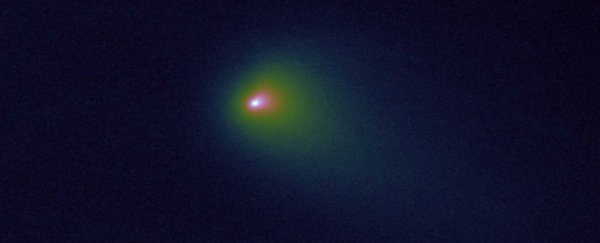A comet that entered our Solar System from interstellar space may not make it out again. As it zooms away from the Sun, 2I/Borisov has been spotted spewing out material in two cometary outbursts.
These outbursts show that the comet is disintegrating, according to Polish astronomers from the Jagiellonian University in Krakow and the University of Warsaw who recorded the activity.
"This behaviour is strongly indicative of an ongoing nucleus fragmentation," they wrote in a notice posted to Astronomers Telegram.
2I/Borisov first drew the world's attention at the end of August last year, when it was officially discovered whizzing through the Solar System on a trajectory that indicated an interstellar origin.
Scientists later pored through observation data, and found images of the comet dating all the way back to December 2018. This wealth of additional data supported conclusions about the comet's interstellar origins, and allowed for a more precise prediction of its future trajectory.
What astronomers were particularly keen to see what happened after the comet reached perihelion - its closest approach to the Sun - on 8 December 2019.
That's because there are two types of comets in the Solar System. Short-period comets typically come from the Kuiper Belt or closer, and have an orbital period of less than 200 years. They are much more likely to stay intact when they go past the Sun.
Long-period, or dynamically new comets come from farther away - the Oort cloud - and are more likely than short-period comets to break up. Analyses of 2I/Borisov's colour and composition found it was very similar to long-period comets, so disintegration due to heating from the Sun was anticipated, but not guaranteed.
"For Solar System comets, it is known that dynamically new comets are 10 times more likely to disintegrate than short-period comets, presumably due to their pristine state and weaker structural strength," wrote researchers led by Quanzhi Ye from the University of Maryland last year.
This would be seen as a change in brightness in the comet - and indeed, this is what has been observed. Between 5 and 9 March 2020, the comet brightened twice.
But although it may be the end of the line for 2I/Borisov - a journey of an unconfirmed number of light-years across space - it's not a sad one. As the comet disintegrates, observations of its spectrum will reveal its internal chemistry, including its nucleus.
It's an excellent opportunity to study the comet's guts, and compare it to our Solar System comets, to see how similar or different they are.
Since comets are thought to be a vital part of the emergence of life here on Earth, those comet guts could help us discover if the ingredients for life are common in our galaxy.
So astronomers will be continuing to closely monitor 2I/Borisov's activity.
